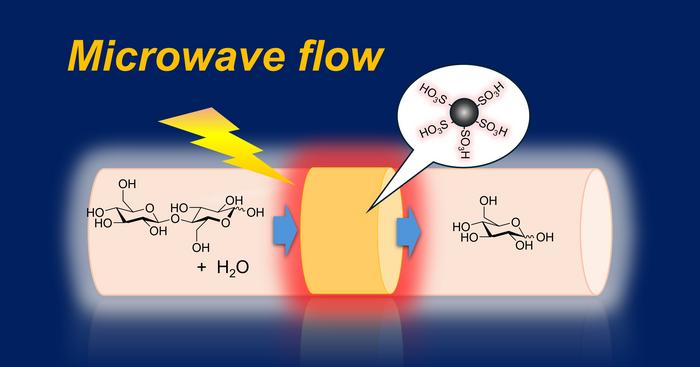
Researchers at Kyushu University in Fukuoka, Japan, have made a significant breakthrough in the field of biomass conversion by developing an innovative device that harnesses the power of microwave flow reactions combined with solid acid catalysts. This cutting-edge technology allows for the efficient conversion of complex polysaccharides into simpler monosaccharides, with cellobiose, a disaccharide composed of two glucose units, serving as a model substrate. The researchers’ findings reveal a promising pathway for the sustainable production of valuable sugars, which have immense applications in food, pharmaceuticals, and chemical manufacturing.
In their pioneering research, the team utilized a continuous-flow hydrolysis process, which involves passing a solution of cellobiose through a sulfonated carbon catalyst. One of the unique aspects of their device is the implementation of microwave heating. The microwave energy, which can achieve localized high temperatures, significantly enhances the catalytic activity of the solid acid catalyst. This innovative approach not only increases the efficiency of the reaction but does so while maintaining a lower overall temperature within the reaction system, highlighting the device’s potential for improved energy conservation.
Traditionally, biomass conversion has presented numerous challenges, particularly due to the complex structure of polysaccharides found in natural resources. These long-chain sugars, prevalent in plant materials, have been a focus of research due to their potential as a renewable resource. By breaking down polysaccharides into simpler sugars, they can be more easily converted into everyday products such as biofuels, polymers, and other valuable chemicals. Hydrolysis, the chemical reaction that facilitates this conversion, has primarily relied on acid catalysts for efficacy; however, the development of solid acid catalysts represents a significant advancement in this area due to their recyclability and sustainability.
Despite their advantages, solid acid catalysts typically require high temperature ranges to activate efficiently, leading researchers to explore alternative methods for enhancing their performance. Associate Professor Shuntaro Tsubaki and his research team recognized that microwave heating could provide a solution. Microwaves generate both electric and magnetic fields, enabling more focused heating effects. By strategically separating these fields, the team was able to optimize the reactions taking place within the device. The electric field effectively sublimates water content in the cellobiose solution, while the magnetic field heats the sulfonated carbon catalyst, maximizing the overall reaction efficiency.
The innovations applied in the creation of this device represent a vast improvement over traditional methods. As the cellobiose solution flows through the catalyst, the targeted heating allows for a rapid breakdown of the disaccharide into glucose. The researchers reported operating conditions involving microwave temperatures of approximately 100-140 degrees Celsius, which further illustrates the energy-efficient nature of the system. This ability to maintain effective catalytic activity with lower temperature requirements could lead to less energy consumption in industrial processes, aligning with the growing demand for sustainability in chemical production.
In addition to its practical applications in biomass management, the research conducted by Tsubaki and his colleagues holds implications for other areas of chemical synthesis. The team’s work opens avenues for exploring the hydrolysis of additional polysaccharides and potentially even proteins, creating a rich field of inquiry around amino acid and peptide production. As more researchers take interest in sustainable methods and renewable resources, the possibilities for this technology could extend well beyond immediate applications.
The impact of this research is amplified in the context of the increasing global emphasis on renewable energy sources and the urgent need for greener practices in industry. Chemical synthesis has long relied on fossil fuel-derived processes, but the integration of electricity-driven methods, such as this microwave-catalyzed system, signals a shift towards environmentally friendly production techniques. Tsubaki’s team notes that leveraging advancements in technology will be vital for addressing the world’s pressing challenges surrounding climate change and resource management.
Their extensive findings have been documented in the scientific journal APS Sustainable Chemistry & Engineering, where they detail both the experimental techniques and the underlying mechanisms behind their device. The team hopes that their research will contribute to ongoing efforts to devise more sustainable methods for chemical synthesis, ultimately leading to innovations that benefit the agricultural and pharmaceutical sectors.
The research conducted by Kyushu University further emphasizes a collective responsibility among scientists and industry professionals to explore and implement technologies that prioritize sustainability and resource efficiency. By promoting knowledge sharing and collaboration in the scientific community, it is possible to accelerate the transition towards more responsible practices and create lasting solutions for global issues.
As renewable energy technology continues to evolve, the potential for microwave-assisted catalytic processes remains vast. Further exploration of the structural dynamics of polysaccharides, coupled with enhancements in catalyst design and delivery mechanisms, holds promise for achieving even higher efficiencies. As researchers like Tsubaki lead the charge toward greener chemical production, the prospects for more sustainable practices in industrial chemistry look increasingly bright.
The findings have not only implications for the immediate field of biomass conversion but also set the stage for a broader conversation about the role of innovative technologies in sustainable development. As institutions and researchers collaborate and share insights, the potential to convert waste into valuable resources becomes increasingly feasible, driving a new era of sustainable practices across various sectors.
By overcoming limitations traditionally associated with biomass processing and creating more efficient systems of conversion, the work of Kyushu University exemplifies the impact of cutting-edge science on real-world applications. This device is just a glimpse into the future of renewable chemistry and the essential movement towards sustainable industrial practices.
Subject of Research: The efficient conversion of polysaccharides into monosaccharides using microwave flow reactions and solid acid catalysts.
Article Title: Efficient Cellobiose Hydrolysis over Sulfonated Carbon Catalyst in a Spatially Separated Microwave Electric- and Magnetic-Field Flow Reactor.
News Publication Date: 16-Dec-2024.
Web References: Kyushu University
References: ACS Sustainable Chemistry & Engineering
Image Credits: Kyushu University/Tsubaki lab
Keywords
Biomass conversion, microwave-assisted reactions, sustainable chemistry, polysaccharides, monosaccharides, solid acid catalyst, hydrolysis, renewable energy, continuous-flow process, chemical synthesis.





